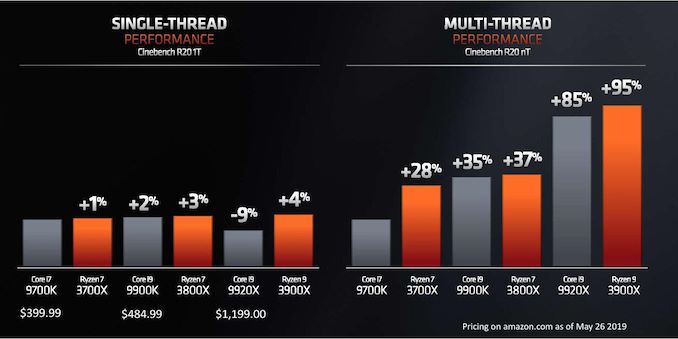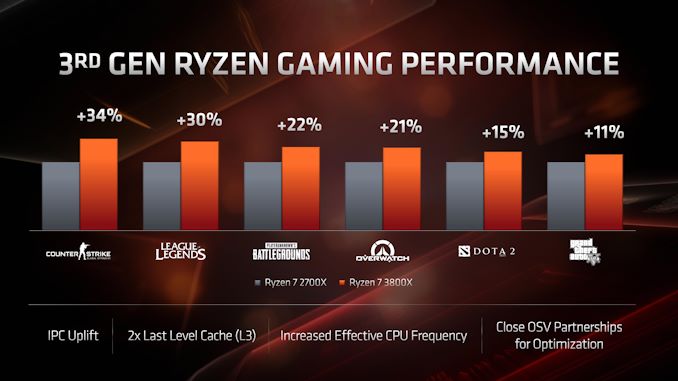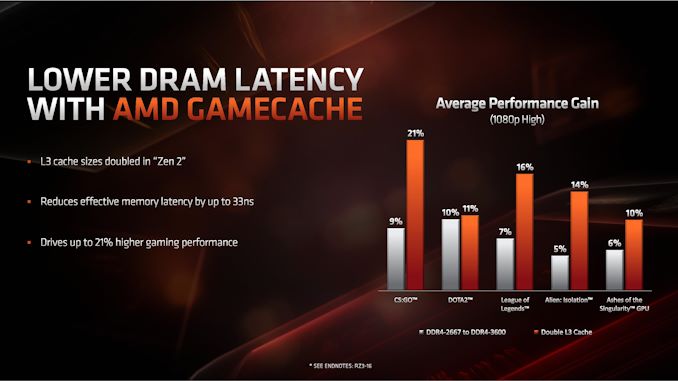AMD Zen 2 Microarchitecture Analysis: Ryzen 3000 and EPYC Rome
by Dr. Ian Cutress on June 10, 2019 7:22 PM EST- Posted in
- CPUs
- AMD
- Ryzen
- EPYC
- Infinity Fabric
- PCIe 4.0
- Zen 2
- Rome
- Ryzen 3000
- Ryzen 3rd Gen
Performance Claims of Zen 2
At Computex, AMD announced that it had designed Zen 2 to offer a direct +15% raw performance gain over its Zen+ platform when comparing two processors at the same frequency. At the same time, AMD also claims that at the same power, Zen 2 will offer greater than a >1.25x performance gain at the same power, or up to half power at the same performance. Combining this together, for select benchmarks, AMD is claiming a +75% performance per watt gain over its previous generation product, and a +45% performance per watt gain over its competition.
These are numbers we can’t verify at this point, as we do not have the products in hand, and when we do the embargo for benchmarking results will lift on July 7th. AMD did spend a good amount of time going through the new changes in the microarchitecture for Zen 2, as well as platform level changes, in order to show how the product has improved over the previous generation.
It should also be noted that at multiple times during AMD’s recent Tech Day, the company stated that they are not interested in going back-and-forth with its primary competition on incremental updates to try and beat one another, which might result in holding technology back. AMD is committed, according to its executives, to pushing the envelope of performance as much as it can every generation, regardless of the competition. Both CEO Dr. Lisa Su, and CTO Mark Papermaster, have said that they expected the timeline of the launch of their Zen 2 portfolio to intersect with a very competitive Intel 10nm product line. Despite this not being the case, the AMD executives stated they are still pushing ahead with their roadmap as planned.
| AMD 'Matisse' Ryzen 3000 Series CPUs | |||||||||||
| AnandTech | Cores Threads |
Base Freq |
Boost Freq |
L2 Cache |
L3 Cache |
PCIe 4.0 |
DDR4 | TDP | Price (SEP) |
||
| Ryzen 9 | 3950X | 16C | 32T | 3.5 | 4.7 | 8 MB | 64 MB | 16+4+4 | 3200 | 105W | $749 |
| Ryzen 9 | 3900X | 12C | 24T | 3.8 | 4.6 | 6 MB | 64 MB | 16+4+4 | 3200 | 105W | $499 |
| Ryzen 7 | 3800X | 8C | 16T | 3.9 | 4.5 | 4 MB | 32 MB | 16+4+4 | 3200 | 105W | $399 |
| Ryzen 7 | 3700X | 8C | 16T | 3.6 | 4.4 | 4 MB | 32 MB | 16+4+4 | 3200 | 65W | $329 |
| Ryzen 5 | 3600X | 6C | 12T | 3.8 | 4.4 | 3 MB | 32 MB | 16+4+4 | 3200 | 95W | $249 |
| Ryzen 5 | 3600 | 6C | 12T | 3.6 | 4.2 | 3 MB | 32 MB | 16+4+4 | 3200 | 65W | $199 |
AMD’s benchmark of choice, when showcasing the performance of its upcoming Matisse processors is Cinebench. Cinebench a floating point benchmark which the company has historically done very well on, and tends to probe the CPU FP performance as well as cache performance, although it ends up often not involving much of the memory subsystem.
Back at CES 2019 in January, AMD showed an un-named 8-core Zen 2 processor against Intel’s high-end 8-core processor, the i9-9900K, on Cinebench R15, where the systems scored about the same result, but with the AMD full system consuming around 1/3 or more less power. For Computex in May, AMD disclosed a lot of the eight and twelve-core details, along with how these chips compare in single and multi-threaded Cinebench R20 results.
AMD is stating that its new processors, when comparing across core counts, offer better single thread performance, better multi-thread performance, at a lower power and a much lower price point when it comes to CPU benchmarks.
When it comes to gaming, AMD is rather bullish on this front. At 1080p, comparing the Ryzen 7 2700X to the Ryzen 7 3800X, AMD is expecting anywhere from a +11% to a +34% increase in frame rates generation to generation.
When it comes to comparing gaming between AMD and Intel processors, AMD stuck to 1080p testing of popular titles, again comparing similar processors for core counts and pricing. In pretty much every comparison, it was a back and forth between the AMD product and the Intel product – AMD would win some, loses some, or draws in others. Here’s the $250 comparison as an example:
Performance in gaming in this case was designed to showcase the frequency and IPC improvements, rather than any benefits from PCIe 4.0. On the frequency side, AMD stated that despite the 7nm die shrink and higher resistivity of the pathways, they were able to extract a higher frequency out of the 7nm TSMC process compared to 14nm and 12nm from Global Foundries.
AMD also made commentary about the new L3 cache design, as it moves from 2 MB/core to 4 MB/core. Doubling the L3 cache, according to AMD, affords an additional +11% to +21% increase in performance at 1080p for gaming with a discrete GPU.
There are some new instructions on Zen 2 that would be able to assist in verifying these numbers.















216 Comments
View All Comments
Thunder 57 - Sunday, June 16, 2019 - link
It appears they traded half the L1 instruction cache to double the uop cache. They doubled the associativity to keep the same hit rate but it will hold fewer instructions. However, the micro-op cache holds already decoded instructions and if there is a hit there it saves a few stages in the pipeline for decoding, which saves power and increases performance.phoenix_rizzen - Tuesday, June 11, 2019 - link
From the article:"Zen 2 will offer greater than a >1.25x performance gain at the same power,"
I don't think that means what you meant. :) 1.25x gain would be 225% or over 2x the performance. I think you meant either:
"Zen 2 will offer greater than a 25% performance gain at the same power,"
or maybe:
"Zen 2 will offer greater than 125% performance at the same power,"
or possibly:
"Zen 2 will offer greater than 1.25x performance at the same power,"
phoenix_rizzen - Tuesday, June 11, 2019 - link
From the article:"With Matisse staying in the AM4 socket, and Rome in the EPYC socket,"
The server socket name is SP3, not EPYC, so this should read:
"With Matisse staying in the AM4 socket, and Rome in the SP3 socket,"
phoenix_rizzen - Tuesday, June 11, 2019 - link
From the article:"This also becomes somewhat complicated for single core chiplet and dual core chiplet processors,"
core is superfluous here. The chiplets are up to 8-core. You probably mean "single chiplet and dual chiplet processors".
scineram - Wednesday, June 12, 2019 - link
No, becausethere is no single chiplet. It is the core chiplet that is either 1 or 2 in number.phoenix_rizzen - Tuesday, June 11, 2019 - link
From the article:"all of this also needs to be taken into consideration as provide the optimal path for signaling"
"as" should be "to"
thesavvymage - Wednesday, June 12, 2019 - link
A 1.25x gain is the exact same as a 25% performance gain, it doesnt meant 225% as you stateddsplover - Tuesday, June 11, 2019 - link
So in other words Anadtech no longer receives engineering samples but tells us what everyone else is saying.Still love coming here as reviews are good, but boy oh boy yuze guys sure slipped down the ladder.
Bring back Anand Shimpli.
Korguz - Wednesday, June 12, 2019 - link
the do still get engineering samples... but usually cpus...not likely.. hes working for apple now....
coburn_c - Wednesday, June 12, 2019 - link
What the heck is UEFI CPPC2?